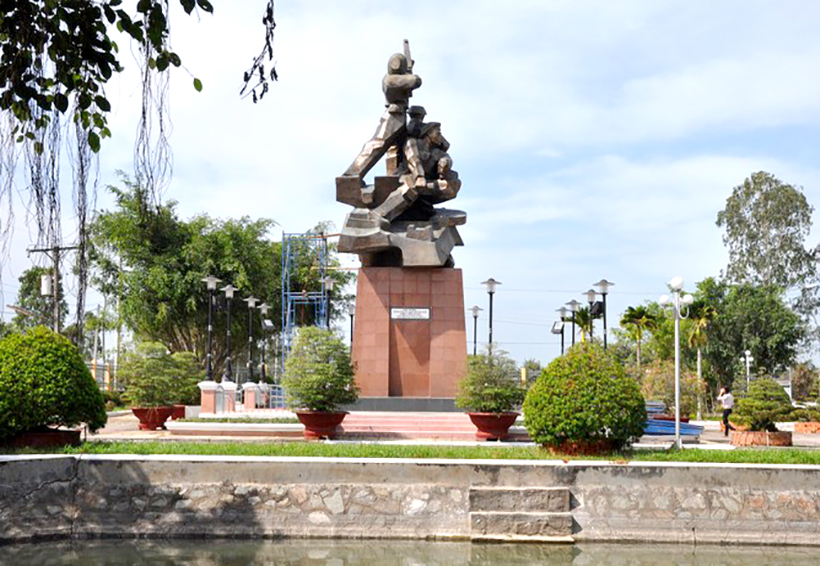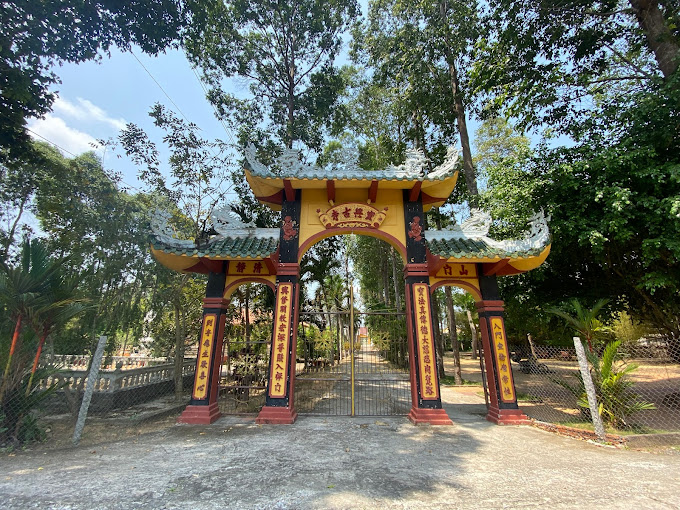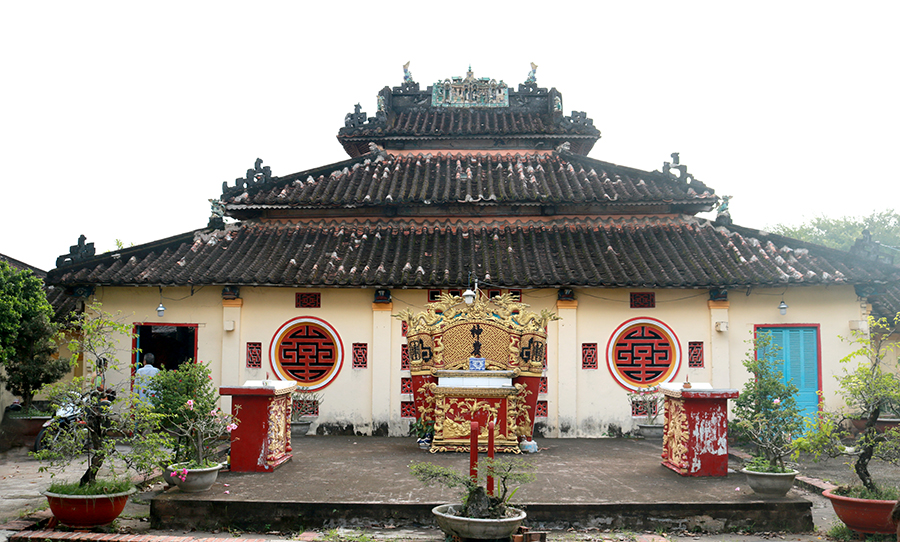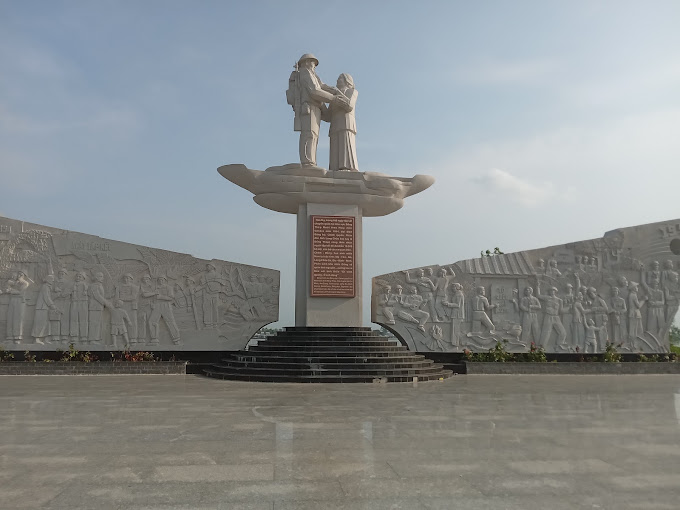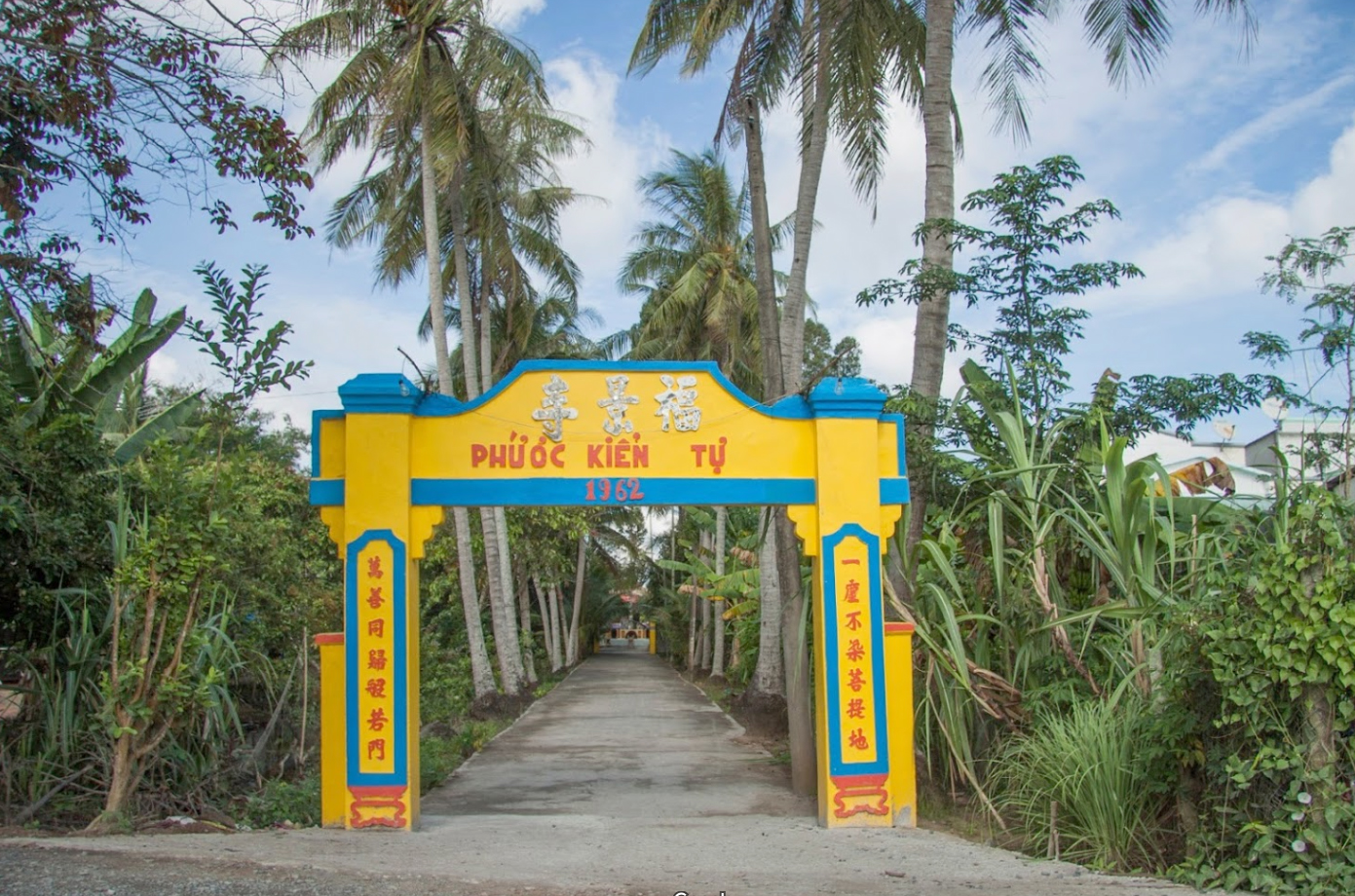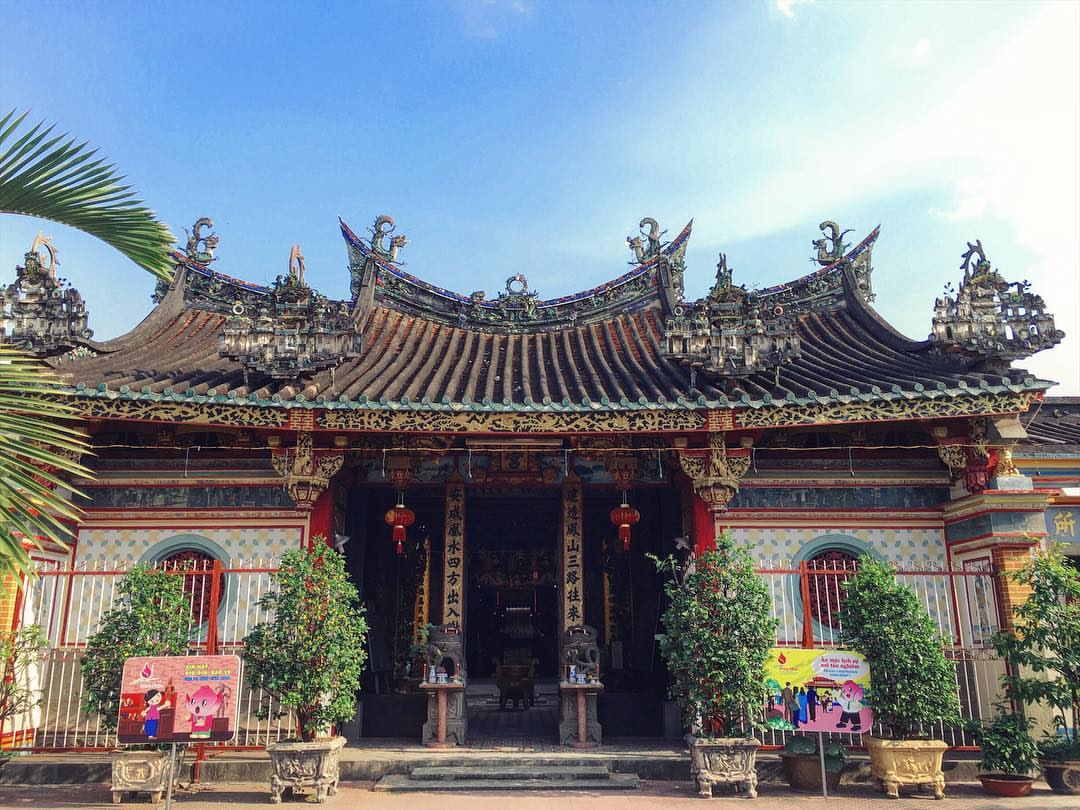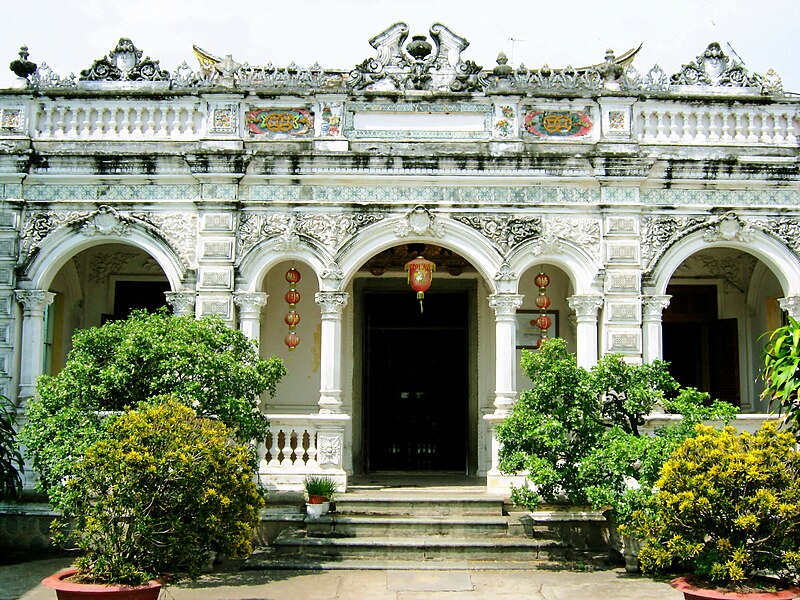Relic point Vietnam
Việt NamTrieu Am Pagoda (Thanh Dao)
Trieu Am Tu (Ong Chin Pagoda) is located in Hoa Dan hamlet, Nhi My commune, Cao Lanh district, Dong Thap province. It is a pagoda following the Buu Son Ky Huong religion of Buddha Master Tay An - Doan Minh Huyen. The pagoda was first founded by Mr. Dang Van Ngoan (also known as Mr. Dao Ngoan) in the year Giap Dan (1854) during the 7th year of King Tu Duc's reign at Tra Bong canal, Nhi My village, Kien Phong district, Dinh province. Tuong (now Hoa Dan hamlet, Nhi My commune, Cao Lanh district, Dong Thap province). Mr. Dao Ngoan is a great disciple of the "twelve sages" of Buddha Master Tay An. He was born in the year of Canh Thin (the year of Minh Mang, 1820) in a virtuous family in Nhi My village, near Tra Bong canal. When he was over 20 years old, after diligently cultivating land to establish a field and garden so that his family could make a living, he asked his mother to let him leisurely find a quiet place to cultivate his mind and nurture his nature. With his mother's approval, he chose a plot of land in Ong Buong canal to build a thatched hermitage to meditate. Mr. Dao Ngoan studied Buddhism with Buddha and spread Buddha's Buu Son Ky Huong religion, guiding people to set up fields, reclaim land on the outskirts of Dong Thap Muoi and cure people's diseases. He directed his followers to recite Buddha's name and cultivate the Buddha's name, exploiting more than 500 square meters of land. Not long after that, the pagoda caught fire and burned down, followed by several Southern provinces being invaded by the French invaders. During the mutiny, Mr. Dao Ngoan and his followers had to leave the temple to seek refuge. In 1867, Mr. Ngoan returned to Tra Bong to gather followers to rebuild the old pagoda, continue to take medicine to treat people's illnesses and gathered a large number of followers to preach the teachings of the Four Graces, in which the grace of the country comes first. The country's situation is suffering from foreign invasion. Tra Bong Pagoda became a place where patriots gathered to discuss fighting the enemy. On the 19th day of the second lunar month, the year of the Tiger (1890), Mr. Dao Ngoan passed away at the age of 70. His mournful followers gathered together to bury him in accordance with Buddha's teachings. After Mr. Dao Ngoan passed away, the pagoda continued to be cared for by Nguyen Thi Hue (his third wife) and the pagoda. Mr. Dang Cong Hua (Chin Hua's son) was also taught the Dharma and healing methods by Mr. Ngoan and Mrs. Hue, so Tra Bong Pagoda still gathers a large number of followers. When Mr. Chin Hua replaced the abbot of the pagoda, he gave the pagoda a new name, Trieu Am Tu. In addition to the name Trieu Am pagoda that few people know, people still call this "Ong Chin Pagoda" because Mr. Chin's virtue and talent are no less than Mr. Dao Ngoan's. During the resistance war against America In 1965 - 1966, a secret cellar was built at the temple to house provincial and district officials. Every time there was an enemy raid, when they withdrew, the pagoda sounded three loud beeps to signal the cadres to take shelter in the cellar. This secret bunker was used very effectively until the day of liberation on April 30, 1975. From 1973 to April 30, 1975, Cao Lanh Town Party Committee returned to Tra Bong canal near the pagoda, the monks in The pagoda has just served as inter-commune liaison at Nhi My and protected commune officials. Trieu Am Tu (Ong Chin Pagoda) is a place to record traces of revolutionary events, a place to worship the title of Thanh Hoang Bon Canh and Dai Can of the Nam Hai Nation along with the 6-card box of Nhi My communal house which is descended from Mr. Chin's work preserves and maintains incense despite many historical events. The pagoda is also a place to educate patriotic traditions, virtues of compassion, preach and encourage people and believers to follow the teachings of "Four Graces". On December 23, 2019, the People's Committee of Dong Thap province ranked Trieu Am Tu is a Provincial-level historical and cultural relic. Source: Cao Lanh district website, Dong Thap province
Dong Thap 3291 view
Ap Bac Victory Relic Area
Ap Bac belongs to Tan Phu commune (Cai Lay town, Tien Giang) about 21km west of My Tho city center. It is a place known to the whole country and progressive people around the world. It is not a scenic spot, but the place where a resounding battle took place. The battle in which the US and puppet forces concentrated maximum force, using modern warfare equipment and innovative tactics, with American advisors and their henchmen determined to sabotage the revolution, in order to crush Ap Bac and destroy main force of the Southern revolution. On January 2, 1963, with 200 gunmen, the army and people of Ap Bac defeated more than 2,000 enemy troops with aircraft, tanks, warships supporting and American advisors commanding, breaking two new tactics. The period that the US applied in special warfare was "helicopter transport" and "armored transport" signaling the collapse of Ngo Dinh Diem's regime and the special war strategy of the US empire. Early in the morning of January 2, 1963, the enemy launched a sweep by the 7th Division Command and the Security Task Force in Dinh Tuong sub-region. The sweep took place within Tan Phu commune to encircle and destroy our local platoon that they discovered; Our forces only had company 1 of battalion 514 and company 1 of battalion 261. At 5:00 a.m. on January 2, 1963, the enemy divided into two wings to enter Ap Bac, but we blocked and attacked them, forcing them to call in reinforcements. institute. At the same time, our engineering field used mines to sink a ship at Kinh 3 and damaged two others. At 9:30 a.m., they landed a helicopter at Ap Bac; Under the command of company commander Bay Den, we broke up many enemy attacks supported by both helicopters and M113 vehicles. By evening, after many failed attacks, the enemy withdrew from the battlefield. As a result, they failed miserably, with: 450 dead and wounded, including 10 American advisors; 3 M 113 amphibious vehicles were destroyed; 8 helicopters were shot down; 1 ship sank and 2 other ships were damaged. Currently, the relic site is an architectural complex located on an area of nearly 3 hectares including: exhibition house, area recreating the activities of Ap Bac soldiers and people in battle, bronze statues of 3 iron and steel soldiers, area display of trophies after the battle: armored vehicles, helicopters, 105mm artillery; the grave site of 3 iron and steel soldiers: Nguyen Van Dung, Do Van Trach and Hung (don't know their last names); The manor house is interspersed with a flower garden that is always blooming and fragrant. Perhaps the most impressive on the campus is the bronze statue of three tall iron and steel soldiers, weighing 18 tons: one holding a gun, the other holding a gun standing proudly on an enemy tank, their majestic image as if carrying them away. We return to the scene of guns exploding and bombs rumbling more than 50 years ago. The Ap Bac victory is a brilliant milestone in the history of the struggle against foreign invaders of Tien Giang people and our nation. It spoke of the indomitable will of the Vietnamese people, the invincible strength of the people's war. On January 7, 1993, Ap Bac historical relic was ranked as a national relic by the Ministry of Culture and Information (now the Ministry of Culture, Sports and Tourism). Source: Department of Culture, Sports and Tourism of Tien Giang Province
Dong Thap 5349 view
Buu Hung Pagoda
Buu Hung Pagoda is located in Long Thang commune, Lai Vung district, Dong Thap province. Buu Hung ancient pagoda was recognized as a national historical-cultural relic on August 3, 2007. Because the pagoda is located next to Ong Ca Cat canal, people have known this as Ca Cat pagoda for hundreds of years. According to historical records at the pagoda, Zen master Nguyen Dang from Hue capital built Buu Hung pagoda in the mid-18th century, around the years 1777 - 1780, with temporary materials of bamboo, mud walls, and roofing. water coconut leaves. In 1803, the pagoda was named Sac Tu Buu Huong Tu by King Gia Long. Legend has it that once, when the Tay Son army chased them away, Lord Nguyen Phuc Anh (later King Gia Long) had to run to the pagoda for shelter. Remembering his gratitude, after ascending the throne, Lord Nguyen bestowed the title of monk on the pagoda, and at the same time conferred the title of Venerable Tu Dung on monk Tien Thien Tu Lam. In the pagoda there is a sign that reads "Sac tu Buu Hung Tu Gia Long two years old". After that, the monk built the simple pagoda into a large, solid pagoda made of precious wood. In 1821, under the reign of King Minh Mang, Minh Tinh Buu Thanh and Minh Phuoc Tu Trung built a larger pagoda and the court offered a 1.8m high wooden Amitabha Buddha statue and other dharma objects for worship. In 1910, during the reign of Patriarch Nhu Ly, Thien Truong (1887 - 1969), the pagoda was majorly restored. During the years 1909 - 1911, the monk repaired the main hall, carved more altar panels, altar plates, horizontal panels, parallel sentences... At the same time, the monk also repaired the tomb tower and planted more ornamental trees. So the temple is even more beautiful and majestic. In September 1946, the pagoda was bombed by a plane and hit the ancestral house, killing the abbot Chanh Vien and four Buddhists. Responding to the resistance against the French, the pagoda donated a large donation to the revolution to manufacture weapons to fight the French. After that, Venerable Chon Hoa (1950 - 1966) became the abbot to rebuild the ancestral house as before, and the pagoda gradually flourished again as before. In 2002, the pagoda was renovated, the roof was covered with glass tiles, and the floor was tiled with ceramic tiles. The original bas-relief columns and four-quarter carvings are very unique and skillful. Regarding construction architecture, Buu Hung Pagoda is currently located on an area of about 4,000 square meters, designed in a triangle style with a width of 15 meters and a length of 50 meters including: Front hall, Main hall and Hau To house. The front hall and main hall are connected to each other. The main hall consists of three rooms and two large wings in the style of four pillars, with many lamellas, the Than Vong is very delicately carved with four sacred animals, and the Nguyen dynasty sent it as an offering in 1821. Behind the main hall of the pagoda is an open-air courtyard (provincial courtyard) shaped like a mouth, with corridors on both sides (East corridor, West corridor) connecting to the Hau To's house. In the bamboo garden next to the pagoda is an ancient tower. This is the resting place of the monks who have practiced at the temple. In addition to the ancient architecture, a special feature of Buu Hung Pagoda is that most of the Buddha statues in the pagoda are made of many types of precious wood that are hundreds of years old. Notably, the Amitabha Buddha statue made of wood sent by the Nguyen court as an offering in the 2nd year of Minh Mang (1821) is placed in the middle of the main hall. Currently, the pagoda still has more than 100 large and precious wooden pillars, three sets of large wooden doors (each door has 4 wings) with very artistic carvings of dragons and flowers. These three sets of doors were made in the early 20th century and were installed on the back wall of the Main Hall in the years 1909 - 1911. Source: Dong Thap Tourism
Dong Thap 3573 view
Dinh Yen Communal House
Dinh Yen communal house was built in the year of Canh Tuat 1909, located in An Loi A hamlet, Dinh Yen commune, Lap Vo district - Dong Thap. Local legend has it that: in the past, there was Mr. Pham Van An who was the first person to choose this place to reclaim land and establish a hamlet to settle down. To pay tribute to those who came before, the people here took his name and combined it with the word Dinh and named the village Dinh Yen (because they avoided calling the name An), hence the name Dinh Dinh Yen. The communal house is built in the style of domestic and foreign countries, with walls built with wooden columns, roofed with large tube tiles, flags, rafters and columns carved with clever and beautiful dragon head patterns. Parallel sentences and bamboo tureens are decorated with conch, carved with dragon-shaped fish, two dragons, painted with pearls, lotus, peonies... lacquered and gilded. The landscape paintings and frescoes have sharp lines, praising the country's people for literature, martial arts, wisdom, and virtue. In front of the communal house's spacious cement-floored yard with fragrant flower beds, rows of ancient poplar trees, oil trees, and tall stars swaying in the wind, evoking the scene of the old people still here somewhere. The inside and outside are skillfully arranged in harmony and balance, making the architectural work truly magnificent and splendid. At the communal house (main hall) on a high platform worship the god Thanh Hoang Bon Canh. Both sides of the ceiling are solemnly decorated with dragons, unicorns, tortoises, phoenixes, cranes, god thrones, incense burners, ashes, parasols... On both sides of the altar, the left and right sides are arranged to worship the ancestors of the communal house. . Every year on the 16th - 17th day of April and the 15th - 16th day of the 11th lunar month, the communal house worship ceremony takes place solemnly with full rituals such as: cavalry team, lion team, soldiers, students, drums, etc. gongs, ceremonial music... Coming to Dinh Yen communal house with reverence and remembering the merits of the ancients to their homeland, only then can we understand the word "God". That is the heroic spirit of the ancestors as if still mixed in the incense and smoke, always protecting many people and existing eternally in the hearts of the People. Source: Dong Thap Tourism
Dong Thap 4061 view
Tan Phu Trung communal house
Tan Phu Trung communal house is located on a large plot of land, in the middle of a rich countryside in Tan Phu Trung commune, Chau Thanh district, and is one of the ancient communal houses in Dong Thap that is worth a visit for tourists. Tan Phu Trung communal house worships the god Thanh Hoang Bon Canh, conferred by King Tu Duc in 1854. Tan Phu Trung village communal house was greatly restored in 1952, 1957... Up to now, Tan Phu Trung communal house is one of the communal houses with architectural ideas. The architecture is quite typical of Southern communal houses during the Nguyen Dynasty in the early 20th century. Looking at the gate, we can see the main buildings: communal house gate, communal house yard, main communal house and Huong Hoi house. The main gate is right in front of the main communal house, 3m wide, 3.5m high. The gate pillar is made of sturdy bricks, with a ceramic unicorn statue on top. Embossed horizontal bar of the communal house gate: Tan Phu Trung Communal House. The communal house's yard is large, tiled, and in the middle is an 8m high flagpole. At the foot of the flagpole is the Xa Tac altar. In front of the Xa Tac Dan is a Binh Phong, in front is a painting of a pair of dragons winding in the clouds, behind is a tiger descending the mountain (lower mountain forest). Balanced in the courtyard, on the right is the Son Than (Tiger God) Temple, symmetrically is the Ngu Hanh (Ngu Nuong) Temple. Just in the courtyard of the communal house, there are countless symbols of the spiritual, cultural life and thinking of agricultural residents The main communal house consists of three blocks of houses in an arranged arrangement, each house has four main columns, also four pillars, along which the trusses and rafters are pierced to four sides, called the four images, on each rafter there is also a rafter, on top That's a set of sesame rafters... creating a sturdy communal roof. The main communal house has three roofs, like an upper floor and a lower porch, with overlapping terraces. The communal house's roof is covered with yin and yang tiles, the top is elaborately decorated with two dragons painting pearls, fish turning into dragons, unicorns playing with mothers and children, eight fairies, phoenixes holding scrolls... In the communal house, there are many carvings of horizontal panels, bamboo panels, and couplets with popular themes such as: Dragon, Unicorn, Quy, Phung, spring - summer - autumn - winter, stylized flowers and leaves. In particular, the communal house has 3 statues of Saint - Emperor - Quan made of rare and precious agarwood that are still preserved. Tan Phu Trung Communal House is not only a long-standing architectural work of the local people but also a place to preserve typical community cultural and religious activities, contributing to preserving indigenous culture. On August 15, 2012, Dinh Tan Phu Trung received the Certificate of recognition as a national historical and cultural relic. Every year, Tan Phu Trung village communal house festival takes place on the 16th - 17th day of the fourth lunar month (even years) and the 12th - 13th day of the fifth lunar month (odd years) attracting tens of thousands of tourists to Dong Thap. Visit, worship, pray for peace in the country and people, a year of good rain and wind, lush crops, good business, prosperous and prosperous villages... Source: Dong Thap Tourism
Dong Thap 5051 view
Monument to the 1954 Gathering event
On October 29, 1954, at Cao Lanh North Wharf, a special event took place - The send-off of tens of thousands of Southern officers, soldiers, and students gathering to the North. This is a military movement of great significance: bringing officers, soldiers, and students from the South to the North to work and study in order to train cadres for the Southern revolution and build a socialist North. to create a solid rear base to liberate the South and unify the country. 66 years have passed, but the event of gathering troops to move to the North in 1954 in Cao Lanh still retains its value, deepening the revolutionary tradition of the country's homeland. Cao Lanh North Wharf is the place to send off officers, soldiers, and students from provinces: My, Tan, Go, Long Chau Sa, Gia, Dinh, Ninh, Eastern Inter-Region and volunteers leaving their homeland to board training ships. connect to the North. The gathering to move troops to the North in Cao Lanh took place in 3 phases (August to October 1954) with a total of 13,508 people (of which Long Chau Sa province, now Dong Thap, was 2,655 people). During the gathering days in Cao Lanh, the image of Uncle Ho's soldiers was very dear and close. Demonstrates the bond between soldiers and people like fish and water. The compatriots welcomed soldiers and family members like family members, eating together, living together, working together. With the historical significance and stature of the event of moving troops to the North in 1954 still remaining valid, in order to educate revolutionary traditions, foster patriotism for cadres, party members and people, especially is the young generation; Dong Thap province received financial support from provinces and cities: Ho Chi Minh City, An Giang, Tien Giang, Long An, Binh Phuoc, Binh Duong, Dong Nai and Tay Ninh provinces organized the construction of the Monument. commemorate this historical event with an area of over 12,000 square meters, right at the location of the gathering event to move troops to the North in 1954 in Cao Lanh (Group 6, Ward 6, Cao Lanh city, Dong Thap province). The overall layout of the Monument campus looks like a blooming lotus next to the gentle, poetic Tien River. Located in the center are statues of two figures: the Southern Mother and the British soldier. The image of a mother sending her child off to the gathering - the mother puts a bandana on her beloved child's shoulder, a typical product of the Southern region, implying the sacred sentiments of the South to Uncle Ho and the North. relatives, and also implies that those who leave do not forget their roots so that one day they can return to reunite, Leaving to return. And they truly returned after "21 years of reconnection" when the country was completely unified by the victorious Ho Chi Minh campaign in the Spring of 1975. On both sides of the Monument are two relief panels shown on both the front and back sides. The overall relief has the image of an iron ship sending people off to gather, and is also an image of lotus leaves in a lotus pond - a characteristic of Dong Thap countryside. The relief panel on the right side of the Monument: Portrays activities filled with love for the army and people during the gathering days in Cao Lanh. The relief panel on the left side of the Monument: Depicts the scene of the farewell ceremony for the delegation of Southern officers, soldiers and students on the train to the North in 1954. The monument of the gathering event to move troops to the North in 1954 in Cao Lanh was ranked a National Monument by the Ministry of Culture, Sports and Tourism on October 29, 2019. Source: Dong Thap Department of Culture, Sports and Tourism
Dong Thap 3824 view
Phuoc Kien Tu (Lotus Leaf Pagoda)
Phuoc Kien Pagoda is located in Hoa Tan commune, Chau Thanh district, Dong Thap province, established before the reign of King Thieu Tri. The pagoda is ranked as a historical-cultural relic by the Ministry of Culture, Sports and Tourism. According to abbot Thich Hue Tu, in the past the pagoda was very large, majestic, and possessed a spacious, pure, and cool space. Phuoc Kien Tu Pagoda was also an operational base, raising the mark of revolutionary cadres. However, unfortunately in 1966, war bombs completely collapsed the temple. After 1975, the pagoda was rebuilt with a simple, uncomplicated architecture including: entrance gate, Guanyin worshiping tower and main hall. Bomb craters are used by monks in the temple as lotus ponds. In the lotus pond there is a strange and rare lotus species not only found in Vietnam but also in Southeast Asian countries. The lotus pond at Phuoc Kien Pagoda has a square shape symbolizing the earth, and the lotus leaf has a round shape symbolizing heaven. Huge lotus leaves, as big as stilts, with a curved rim nearly an inch wide, very beautiful. It is known that this lotus species appeared in the temple's pond in 1992 and has existed until now. No one knows their exact name, so people often call them by many different names. Some people call it the king's lotus, sometimes it is called the lotus king, other times it is called the lotus, etc. Because of the strange lotus species, people often call the pagoda by the popular name "Lotus King Pagoda" or "Lotus Leaf Pagoda"... King lotus leaves are special in that they can shrink with the seasons. In the dry season, the leaves are only about 1 meter long, but in the wet season, the leaves are large with a diameter of 3 to 4 meters. The edges of the leaves are about 3 to 5cm above the water surface, their shape resembles the strappy hats of Quan Ho village girls. During the flood season, large lotus leaves can easily hold a person weighing 70 - 80 pounds without only slightly shaking the water surface. In the dry season, lotus leaves are only about 1 - 1.5 meters long. The upper surface of the leaf is smooth and light green, while the lower surface is thorny and has many large veins, divided into squares that are light red when young and gradually darken as the leaf ages. Lotus flowers bloom for 3 days and bloom twice a day, changing color continuously. The flowers bloom for the first time around 6 pm, radiating a fragrant scent until 12 am the next morning, then begin to close. At about 3 o'clock the flowers bloom again, and at about 4 - 5 p.m. they close their petals. From the initial pink-white color, each time the flower blooms it will get a little darker until it fades to a dark purple color. Phuoc Kien Pagoda is also associated with the story of the magical turtle and magical crane. In 1948, someone brought a turtle to the temple. This turtle hangs around the monk all day long, eating only vegetarian food and listening to Buddha's chanting. In 1966, the devastating war left the pagoda devastated and the turtles were taken away, but then the turtle thief brought the turtles to the pagoda to confess his crime. In 1999, a crane appeared in the temple and it often perched on the turtle's back, but later, there was an idea to capture the crane and return it to the conservation area. From then on, people no longer saw the crane, the crane flew away, and the turtle also passed away. The abbot embalmed the turtle's body and wore a rosary around his neck, placing it in a glass cage in the temple. Source: Dong Thap Trade, Tourism and Investment Promotion Center
Dong Thap 4064 view
Kien An Cung (Ong Quach Pagoda)
Kien An Cung, commonly known as Mr. Quach Pagoda, is a temple located in the center of Sa Dec city (No. 39 Phan Boi Chau Street, Ward 1, Sa Dec city, Dong Thap province), facing the canal. Cai Son. The temple was built from 1924 to 1927 by Chinese people from Fujian. The pagoda has bold Chinese architecture, with an overall shape of the letter Cong consisting of three compartments: Dong corridor, Tay corridor and the main hall is larger. The tile roof consists of 3 layers, the top is tile, the middle is tile, and the bottom is tile. The tiles are roofed in dragon waves, covering the ground for the curved waves to rise high, creating a tile roof in the "five elements" style. Each end of the wave is a miniature palace, including 6 palaces. The entire pagoda There are no rafters, only wooden beams that bear the force on round wooden pillars. On the walls of the pagoda are images from Journey to the West, Romance of the Three Kingdoms,... At the entrance are two unicorns. made of very large green stone, above is a splendid lacquered and gilded diaphragm. In the middle of the main hall is the space to worship Quang Trach Ton Vuong. His statue is cast in red bronze with a kind face, holding a jade belt, next to two other gods. On his right side is the place to worship Patriarch Thanh Thuy, on the left is Bao Sanh the Great Emperor. The two outer rooms, Dong Lang and Tay Lang, are places to worship a number of other gods such as Quan Thanh De Quan... Above the altars there is a horizontal panel with four Chinese characters "Phu Bao An Dong". On both sides of the column are a pair of tureens: Dong village wishes the Holy Virtue to restore the Hao Trac Thanh palace Phu My thanked the gods and opened a magnificent temple Since its construction, the pagoda has been restored three times but is still located in the same location. Every year the pagoda has two major festivals on February 22 of the lunar calendar and August 22 of the lunar calendar, welcoming many visitors. With Chinese-style architecture and a unique traditional culture, Kien An Cung was recognized by the Ministry of Culture and Information as a national historical-cultural relic on April 27. 1990. Source: Dong Thap Tourism
Dong Thap 4267 view
Huynh Thuy Le ancient house
Huynh Thuy Le ancient house is located at 255A, Nguyen Hue street, ward 2, Sa Dec city, Dong Thap province. The ancient house was built in 1895 by Mr. Huynh Cam Thuan, a famous and wealthy Chinese businessman (Fujian, China) in Sa Dec in 1895 in the bustling shopping area along the Sa Dec river. The house was built with a unique combination of East and West architectural styles, especially this ancient house is also famous for being related to a borderless love affair between a French female writer named Marguerite Duras and a young man. Chinese-Vietnamese named Huynh Thuy Le, son of Mr. Huynh Cam Thuan - the owner of the house. In 1929, Marguerite Duras and Young Master Huynh Thuy Le met and fell in love at first sight. However, after 18 months of love, because of Mr. Huynh Cam Thuan's vehement opposition, this relationship had to end and Marguerite Duras had to decide to give up and return to France. Later, Huynh Thuy Le had to obey the family to marry a girl of Chinese origin. This love affair later became a memoir for her to write the famous novel The Lover in 1984. This work was adapted into the film L'Amant in 1992 by French director Jean-Jaques Annaud. Huynh Thuy Le ancient house is a harmonious combination of Eastern and Western architecture. The entire house is built on an area of 258 square meters and is shaped in the style of a traditional Vietnamese house, with a yin-yang tiled roof and two curved boat-shaped gables in the style of a Northern pagoda to create a soft look. roof. However, the architecture inside the house is tall and airy, the walls are built of very thick solid bricks from 30-40cm covering the wooden frame structure, increasing the load-bearing capacity in accordance with traditional French architecture. The house has three rooms, decorated inside in Chinese style. The balconies and railings are painted with gold and carved very similar to Chinese pagodas. The middle balcony frame has a double Loan Phung carving representing "Loan Phung Hoa Minh Sac Cam Dao" which means eternal happiness. . The frames on both sides are carved with birds, flowers and leaves, representing the family's prosperity. In particular, in the middle of the main house there is a worship of Quan Cong, a traditional Chinese belief; At the same time, it also shows strength and prosperity in life. The wooden doors, cabinets, beds, and altars are all carved very elaborately and delicately. In 2008, Huynh Thuy Le Ancient House was recognized as a Provincial Historical Site and in 2009 it was recognized as a National Historical Site. Source: Dong Thap Tourism
Dong Thap 4113 view
Xeo Quyt Relic Area
Xeo Quyt relic site is located on the territory of two communes My Long and My Hiep, Cao Lanh district, Dong Thap province, with a total area of 70 hectares. From 1960 to 1975, the Kien Phong Provincial Party Committee (now Dong Thap) chose this place as a base to lead the people of the province to join the whole country in successfully carrying out the resistance war against America to save the country. In the past, this place was a desolate, swampy land, full of weeds and alum-contaminated fresh water, full of mosquitoes and leeches. The accommodation and activities of the Provincial Party Committee mainly rely on the support and protection of the people around the area and must dig ditches to prevent enemy tanks, build fortifications and plant trees to create forests for shelter. and activity. Around this base, with a radius of 6 km, is an almost closed system of more than 10 enemy posts. Among them, there are two stations about 1 km from the base area. During the war, this place was a free range, free bombardment area, a "firing range" and a "helicopter training ground" for the enemy. Many times B52 aircraft, M113 amphibious vehicles, flying boats, artillery combined with enemy infantry continuously bombed, swept, and bombarded the base area, trying to destroy all life on this land. Therefore, Xeo Quyt became a very fierce war zone. There are times when the Provincial Party Committee has to face life and death narrowly. To operate and survive until the day of complete victory, on the one hand, the Provincial Party Committee has shown strategic intelligence, courageous perseverance, and endured hardships to cling to the land and people "not one inch, not one inch". to move", must have a suitable type of living to live and live well in the delta, delta, wet season (must travel and work on canoes)... On the other hand, the Provincial Party Committee's existence is due to a very good gesture. noble and beautiful: "Xeo Quyt lies right in the hearts of the people". This is a decisive factor for the survival and safety of the base. Therefore, today Xeo Quyt is called "THE BASE OF THE PEOPLE'S HEART". Xeo Quyt is divided into 2 areas: Area 1 is about 50 hectares, Area 2 is about 20 hectares. Area 1 is an area that preserves the historical and cultural values of the revolutionary base during the resistance war and the natural ecological diversity... Area 2 is the development area for business activities, tourism and picnic services such as: Restaurants, Conference Halls, outdoor food areas, recreational fishing, river experience games... Provincial Party Committee Hall - where many large conferences take place, proposing important policies and resolutions to lead the province's revolutionary movement; office of the clerical unit; combat fortifications, bomb shelters, secret bunkers, burial grounds, death grounds... Currently, Xeo Quyt has 170 species of plants (with 158 wild species) and 12 species of woody plants. Although not rare, they are adapted to flooded conditions. The fauna has 200 wild species including 7 species of frogs, 22 species of reptiles, 73 species of fish, 91 species of birds and 7 species of mammals. In particular, there are 13 rare animal species recorded in Vietnam's red book: pythons, cobras, box turtles, broad-billed citronella birds and common otters... Old cajuput carpets and populations of water hyacinths. These are two types that are now almost no longer found in other areas of Dong Thap Muoi. Many melaleuca trees with a lifespan of more than 30 years grow high, along with a system of vines clinging around, forming giant cone-shaped blocks. With those important historical marks, on April 9, 1992, Xeo Quyt was recognized as a national historical and cultural relic by the Ministry of Culture and Information. Source: Dong Thap Tourism
Dong Thap 3923 view

